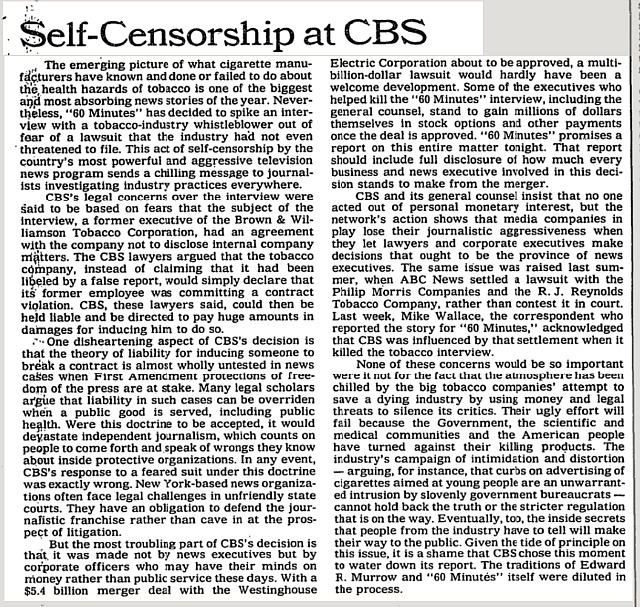The night before last (12.19) a special 20th anniversary screening of Michael Mann‘s The Insider happened at the DGA Theater in Los Angeles. This followed an identical event that happened at the Museum of Modern Art on 11.1. Usually such screenings serve as a promotional bounce for a forthcoming remastered Bluray (like a 4K version), but I’m not aware of any such plan for The Insider. A standard 1080p Bluray, the yield of “a new digital restoration”, was released by Touchstone Video on 2.19.13.
Most Mann-ophiles will insist that Heat is his grandest film, but I honestly find The Insider a better effort in nearly every regard — more exacting, complex, subtle, layered, intelligent. And certainly more real world. And without any annoying Waingro problems. No downtown LA shoot-out and no legendary Pacino-DeNiro conversation at Kate Mantilini’s, but The Insider is all adults, all hotels and corporate offices, all the time.
And with so many great Pacino moments (and not just the usual howling rants)! Not to mention one of the greatest Christopher Plummer performances of all time. Not to mention the absolute highlight of Bruce McGill‘s film career — “Wipe that smirk off your face!”
F.X. Feeney: “I’d admired Manhunter, Last of the Mohicans and Heat as individual films — but it was watching Mann penetrate the contemporary world of corporate authority, in which matters of life and death are decided over desks and behind closed doors, that the living totality and cumulative value of his filmography became unmistakable, and a source of abiding amazement.”
Two decades later I remain astonished by how Touchstone marketing failed to convey the simple fact that The Insider isn’t about the evils of tobacco, but about the glory (and the enormous difficulty) of good journalism vs. the evils of corporatism, and specifically about CBS corporate diluting a major 1995 60 Minutes story about big tobacco whistleblower Jeffrey Wigand.

BTW: I’m told that Mann “screened a VERY special print at the DGA. It perhaps could’ve only happened there because of the amazing new technical capabilities. The print was the Hero EK answer print and it’s Super 35 – EK just stands for the Ektachrome film stock they used, it’s what they call the print that is made directly from the cut camera negative. They would make a few versions of this print adjusting the chemistry each time to adjust light/dark and color – old school color-timing done photochemically in the lab! The “Hero” EK is the set of reels wherein they achieved the final color timing. From this the studio would make their internegative, from which every other print in existence is struck, either directly like the one we screened in NY at MoMA, or with varying generations of dub. That’s why the color was so beautiful the other night — this is the actual print Michael Mann and Dante would have been looking at when they said ‘yes, we’re done, this color is perfect.’
“Also, a normal show print would have the image squished anamorphically onto one side of the 35mm film, and the soundtrack would be squeezed on the other side. The projector would be fitted with an anamorphic lens that would stretch the image back out onto the screen to look normal. Our print is silent, and it’s Super 35, so that means image is printed on the film exactly how it was shot in camera (super 35) and the image takes up the full frame on the film, rather than sharing it with soundtrack. That’s why the image quality was so clean.
“Because the print is silent, we had to bring in some old-school mag dubbers to have the sound playback, Tim Webber and BJ Serviss over at DGA really went to great lengths to locate one of those in working order. It’s the size of a large refrigerator 🙂 We played the Original Printmaster 6-track mag soundtrack. When they are mixing an analog soundtrack they have all these different sound elements, score, dialogue, foley, etc. and they mix them down onto 6 separate tracks on a single piece of magnetic film, elements weave in and out throughout the film and it’s all very carefully calibrated. For a normal show print, a copy would have been made, printed alongside the anamorphically squished image on one piece of film. We had 2 different systems running, the mag playback for sound and the 2 film projectors.”









